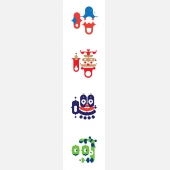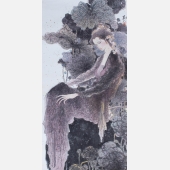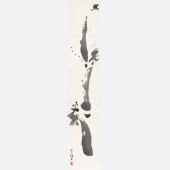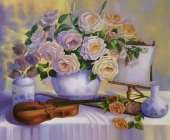- 资质:AGA
- 评分:
1分 2分 3分 4分 5分 6分 7分 8分 9分 10分 9分
- 印象:
- 经营时间:16年
- 展厅面积:
- 地 区:北京-朝阳-22院街
曹力:《一棵老树———记挚友启基》
2018-08-05 15:13:46 作者:曹力 来源:北京德滋画廊
一棵老树
——记挚友启基
文\曹 力
艺术圈的朋友都称启基叫:“幺哥”。陈启基这个名字似乎已被人们遗忘,可我自七十年代起就称“启基”,直到现在,时间长了,越老越亲切。“幺哥”大慨是八十年代后才有人这样叫他的吧?
我在就读中央美院时,有一次回贵阳,我们在郊外画画,看到启基画的画还不错,我就问启基:“你怎么不去报考美院呢? ”他回答:“超龄了。”是啊,那时他已经三十多岁了。时代决定了他不能是科班,命运决定了他只能生长在野地。启基命运坎坷,从小失孤,随姐姐长大,生活艰辛,在孤儿的苦难生涯中开始学画,他终于在艺术中找到了心灵的安慰和生活的勇气。启基在他长长的人生道路上始终与艺术自然地结合在一起——生活即艺术,艺术即生活,直到现在……
我在中央美院完成学业后留校任教的几十年中,与启基的接触并不是很多,但是,几乎每年回到贵阳的第一件事就是给他打个电话,相约某日去某个地方走走。这个相约从未间断,几十年如一日,一样的亲切,一样的无所不谈,一样的热爱郊外的山山水水,一草一木,志同道合,心心相应。记得有一次在启基家聊天晚了,尽管两家相隔不远,但我还是在启基家住下了,继续谈人生、谈艺术、谈荒山上的野草野果呈现出的种种禅意,直至深夜。
启基像山野里的一棵草、一棵树或是一座山。纯朴自然是他的天性,当艺术不知不觉到来时,就像天上下了一场雨,无喜无忧,自然吸收,不断成长。七十年代他画了许多风景和人物的写生,也进行了一些创作,他在他的油画中向世界询问着:我们从哪里来?我们上哪里去?(高更语)。生活的苍桑,事业的艰辛,使他的油画蒙上了一层辛酸、忧郁的色彩,而那丰富微妙的色调,稚拙有力的造型又让人感到他内心对自然、对生命的热爱。他自由地运用着自然的符号:田野中的玉米,河里的鱼虾,裸体少年,沉沉的山坡。微风吹过,画中传来阵阵淳厚、原朴的气味,让人感动得流泪。到了八十年代,启基的艺术逐渐走向多元化,从摄影、烧陶、木雕、再到编织壁挂的创作。王林先生在“‘瞬间的真实性’——读陈启基先生摄影作品有感”一文中写道:陈启基先生深谙摄影的本质,他从不用虚假的纪实性迷惑人,即使是对象具体的人像摄影,或是运用道具使之具有舞台性、矫饰感,或者是附着物品使之呈现异样感、荒诞性,或通过绘画处理和拼贴添加以造成残缺、破碎、割裂和分解,其目的无非是要把观者的感受引离对象的真实,导向内心的体验。启基把摄影当作玩,当作生活的一部份,其中也包括他的烧陶、木雕以及和好友章治华一起编织了多年的大型壁挂,类似这些作品都有王林、管郁达、张健健等诸多批评家的评述,这里就不一一例举了。
八十年代的某一天,我回到贵阳,走进启基在市中心的一间二十多平米的工作室,里面乱七八糟,到处堆满了编织壁挂用的麻布、各色麻绳、红布黑布、纸张塑料板、园木、煤块,中间还有一个铁炉子和正在编织的壁挂,如战场一般。我顺手拿起一张整开大白纸,中间撕个洞,泼洒了一些颜料,头往里一钻,戴在脖子上,只露出一个头来,启基兴奋,拿出相机开始拍照。就这样,一个长达三年,在室内、过道、屋顶,郊外的行为艺术活动从此拉开了序幕。批评家管郁达曾在文章中评述:“曹力、陈启基、章治华是贵州早期观念艺术和行为艺术的倡导者与实践者。从1988年开始,曹力、陈启基、章治华在贵阳野外,居室等场所策划实施了长达三年的行为艺术活动《人·生命·信仰》,参加者达数十人。与九十年代以后演变为传媒炒作热点的行为艺术表演不同,《人·生命·信仰》这个事件几乎不曾见褚于媒体,故至今尚不为人所知。根据当时留下的一些文件、照片和当事者的回忆大致可以看出,作为贵州早期发生的行为艺术活动,《人·生命·信仰》仍延续了八十年代艺术的终极追问理想与宏大叙事方法,具有很强烈的原始地域表现主义色彩,充满了一种悲壮的、挽歌式的仪式感。”
启基初中还末毕业就辍学了,生活的磨砺竟然让他完成并出版了《我的石阡》一书,这是一部自传性的散文系列,正如《我的石阡》这一书名所示,他主要不是自叙经历,而是随着个人历程,讲述那个时代、那片土地上的人和事。这是一些人的历史,也是一方水土的历史(戴明贤先生语)。从此书中可以感受到启基对“家”有种与众不同的人生体验。在2000年以后,启基收集整理了几十户家庭的历史资料和新老照片,进行了长达近10年的《中国家庭》创作,其作品曾在国内外展出。
近几年,启基又进行了综合材料的实验性创作,他利用泥土、沙子、蓑衣草、煤籽、木节等自然媒材与炳烯等材料的结合,附着于木板或画布上,时而涂抹时而堆集,时而雕刻时而镂空,在泥土、草木、炳烯这些材料的不断重新组合混搭下,赋予着这些无生命的材质以特有的灵性。记得上海月湖美术馆收藏的一幅三联画(360x180cm),就是在灰黄厚重的色调中体现了曾经燃烧过的大地,质朴、粗糙的肌理画面中有着尚未息灭的枯草、木板和书籍,在厚厚的泥土中隐约呈现着稀许的陶片,而在近乎流淌的银灰色和杂草丛中又有卵石、陶钵及草鞋……冥冥中我似乎感觉到在气势磅礴,气氛悲壮的画面下又带有一种祥和与慈悲的禅意。
启基喜欢木,曾经创作过不少抽象的木雕作品,有一次我们去到贵阳郊外的一片大山里,沿着河谷穿行,在小溪边上一户农家的柴火堆里,启基发现了一个园形松树支上的木节,启基扛回去略加整理,一个凝似大脑的木雕令我很欢喜,准备收藏,不料却在中央美院画廊的个展中被北京国际艺苑的刘迅先生收藏了。启基有着木的情结,这也许是他从小就上山砍柴,一直生活在荒野大山中的原故吧!在近几年综合材料的创作中他制作了一幅七米多长的折页——一棵老树,宛若一条巨蟒在苍茫的群山中卷曲着、伸展着。弯曲的树干聚集着厚厚的青苔,蒙蒙的细雨侵蚀着、腐蚀着即将变为朽木化为尘土,整个画面悲壮而苍凉,这不就是启基花了两年时间精心制作的自画像吗?这就是他的生命结构和人生历程。
启基是我的老哥子,也是我艺术历程中的同路人,我们会一起将艺术进行到底!
2015年10月25日于北京
An Old Tree
--About my close friend Qiji
By Cao Li
Members of the art circle all call Qiji “Yaoge”. The name “Chen Qiji” seems to have been forgotten, but I have called him “Qiji” since the 1980s. Even now, as time passes, it becomes more familiar. Perhaps it started from the 1980s when he was named “Yaoge”?
I once came back to Guiyang when I was studying at the Central Academy of Fine Arts. We went out to paint and I noticed that Qiji painted quite well. I then asked him “Why don’t you apply to a fine arts academy?” “I am too old,” he replied. Yes, it was true, because he was over 30 years old at that time. That era decided that he couldn’t receive professional training, and fate dictated that he could only grow in the wild. During his life, Qiji suffered many a setback. He lost his parents when he was a child and lived with his elder sister. Life was hard, and he began to learn to paint during that hard orphan life. He eventually found his soul’s comfort and the courage to live in art. Qiji, on his long life journey, is naturally connected with art. For him, life is art, art is life, even now.
During several decades’ teaching at the Central Academy of Fine Arts after my graduation, I didn’t have much contact with Qiji. However, during almost each of my visits to Guiyang every year my first action was to give him a call. We would make appointments to go somewhere for a walk. Our friendship has never stopped; although it has lasted for several decades, it is as if it’s been just one day, still very intimate. There is nothing we can’t discuss. We love the hills and streams, grasses and trees. We are kindred spirits and seem to have telepathy. Once it was getting dark as our chatting went on. Although the distance from his house to mine is not far, I decided to stay in his house so that we could continue talking about life, art, and the Zen shown by the grasses. We talked till very late that night.
Qiji is as the grass, a tree or a mountain in the wild, and simplicity is his nature. When art comes unwittingly, for Qiji, it’s like rain; no surprises no worries; he absorbs naturally and grows continually. He drew numerous sketches of landscapes and figures, as well as other projects in the 1970s. In his paintings, he questioned “Where did we come from, where will we go?” (Words of Gauguin). Although the changes of his life and the hardships of its course have cast a layer of bitterness and melancholy, the rich subtle tones along with the simple, powerful style makes us feel his love of nature and life. He freely uses natural symbols: corn on farms, fish and shrimp in rivers, naked youths, and dark hillsides. In his paintings, breezes blow; there are waves of pure and simple smells, which move people to cry. In the 1980s, Qiji’s art became more diverse. There were photographs, pottery, wood carvings, and woven wall hangings. Mr. Wang Lin, in his article “The Instantaneous Authenticity—Comments on the Photographs by Mr. Chen Qiji”, said “Mr. Chen Qiji is familiar with the nature of photography. He never uses false documentary to confuse people. Even for specific portrait photography, he either uses props to make it present a natural stage and sense of pretense, or uses attached objects to present a sense of absurdity, or by a type of drawing process and collage effect make it appear incomplete, broken, fragmented or decomposed. All of these were intended to divert viewers’ feelings from the authenticity of objects and guide them into an inner experience. Qiji uses photography as a toy, as a part of his life. Many of his other artworks, like pottery, woodcarvings, and the huge woven wall hangings which have been created together with his good friend Zhang Zhihua over the years, are reviewed by critics including Wang Lin, Guan Yuda and Zhang Jianjian. I will not elaborate here.
On day in the 1980s, I came back to Guiyang and entered into Qiji’s studio which was about 20 square meters and located in the city center. The studio was a mess. As if it were a battlefield, the studio was filled with woven wall hanging materials which included linen, colored ropes, red and black cloth, paper and plastic boards, round wood, and coal. There was also an iron stove and an unfinished woven wall hanging. I picked up a large piece of paper, tore a hole in the middle, spilled some paint on it, inserted my head into the hole, and then wore it around my neck showing only my head. Qiji got excited and immediately took out a camera and began taking photos. Subsequently a three-year long performance art event involving indoors, hallways, roofs and outskirts was started from there. The critic Guan Yuda, in his article, once said: “Cao Li, Chen Qiji and Zhang Zhihua were art advocates and practitioners in Guizhou early conceptual art and performance art. Since 1988, Cao Li, Chen Qiji and Zhang Zhihua have been planning and implementing a three-year long performance art activity “Human •Life • Belief” in the indoors and the wild of Guiyang. The participants have included dozens of people. “Human •Life • Belief”, is different from performance art that evolved into media hype hot topics in the 1990s, and was rarely seen in media. That’s why it was still unknown till now. According to some documents left behind, photos and memories of participants, we could generally say that as one of the early performance art events that occurred in Guizhou, “Human •Life • Belief” continued the ultimate questioning ideal and grand narrative method in the 1980s, having a very strong color of the original and regional expressionism and being filled with a tragic feeling; a sense of elegiac rituality.
Qiji quit school before graduating from junior school. However, the hardships of life made him finish and publish his book “My Shiqian”, which is a series of autobiographical essays. As the book’s name shows, he does not primarily describe his experiences, but based on his personal history, he describes that era, the people and things on that piece of land. This is a people’s history, as well as the history of that piece of land (words of Mr. Dai Mingxian). From this book, we can feel that Qiji has a special life feeling towards “home”. After the year 2000, Qiji collected and compiled historical materials, old and new photos of dozens of households, and has created “Chinese Families” for nearly 10 years. These artworks have been exhibited at home and abroad.
In recent years, Qiji has conducted experimental creation of comprehensive materials. He connects natural mediums such as clay, sand, sedges, coal pieces, and wood knots with materials like acrylics. He then attaches them to wood boards or canvas. He sometimes smears, stacks, carves or hollows them. He constantly reassembles these materials including soil, vegetation and acrylics to endow these inanimate materials with unique spirituality. I remember that the Shanghai Yuehu Art Museum has collected one Triptych (360x180cm) of his artwork. The sallow tone of the painting reflects the once burnt earth. The simple and rough texture contains not-yet-extinguished hay, wood boards and books. The thick mud presents several pieces of pottery. And in the near-flowing silver and weeds there are pebbles, ceramics and sandals…under the magnificent and solemn atmosphere I seem to feel a sense of Zen spirit which is harmony and merciful.
Qi Ji is interested in wood, and has created many abstract carvings. One time, we went to the mountain in the suburb of Guiyang and we traveled along the river valley. In the firewood pile of a farmhouse at the edge of the creek, Qiji found a wood knot on a circular pine branch. He carried it back home and did some collation. In the end it became a wood carving resembling a brain; it made me very happy. I was about to collect it. However, unexpectedly during his solo exhibition in the gallery of Central Academy of Fine Arts, the artwork was acquired by Mr. Liu Xun, director of Beijing International Art. Qiji is obsessed with wood, which is perhaps because he had to cut wood from a very young age and has been living in in the wilderness. In his recent years’ creation of comprehensive materials, he created a seven-meter-long folding work---an old tree. It is like a python curled and stretching in the vast mountains. Thick moss occupies the curved trunk. From the erosion and corrosion of misty rain, it would soon become deadwood; eventually turning into dust. The artwork is tragic and bleak, is it the self-portrait that took Qiji two years to elaborately finish? It is his life structure and life history.
Qiji is my older brother, also my fellow traveler in art history. We will focus on art till the end!
Oct. 25, 2015 in Beijing

 测试艺术家
测试艺术家 卢延光
卢延光 雪山静岩博
雪山静岩博 庞明璇
庞明璇 未知
未知 张大千
张大千 黄琦
黄琦 测试用艺术
测试用艺术




